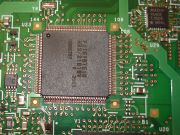Okay, one down, a few more to go. Now we have a fully functional inhibit applet.

Inhibit applet (with wrong icons)
The icons are of course wrong, but I've asked on tango-list for better metaphors (and hopefully better icons).
This applet took about 40 minutes to write. The reason for this is my MATLAB simulations take a long time, and now I can just leave the auto-suspend option enabled and just click one button when matlab is running. The same goes for vmware. Don't use this applet if you just use GNOME software, instead file a bug to make the application use the Inhibit() and UnInhibit() methods as this stuff should “just work”.


